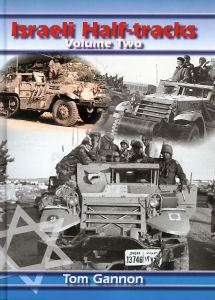
Israeli Halftracks Vol 2 Book Review
By Cookie Sewell
| Date of Review | November 2009 | Title | Israeli Halftracks Vol 2 |
|---|---|---|---|
| Author | Tom Gannon | Publisher | Barbarossa Books |
| Published | 2009 | ISBN | 978-1-84768-002-0 |
| Format | 219 pages, softbound | MSRP (BP) | £32.50 (approximately US$53.00) |
Review
Tom Gannon is well-known in armor history and modeling circles for his work on American M4 series Sherman tanks, and has written a very definitive history of their service in the Israeli Defense Forces. After about a ten year gap, he has now added the next stage in his coverage of this unique and fascinating history with not one but two volumes on the use of halftracks and light armored vehicles by the IDF, starting in 1948 and moving up through the present.
In Volume 2 Tom begins Chapter 6 and coverage of the Israeli use of the White Scout Car and also the French AML90 armored car.
Chapter 7 is the “meat” of the books, for it covers the post-1960 developments of the halftracks including their use and participation in both the 1967 and 1973 wars as well as other uses of the vehicles. Tom begins by commenting on the evolution of markings and registration numbers, pointing out that the IDF finally standardized these items into what we recognize today as pretty much normal force-wide applications. By this time the IDF had also pretty much cornered the market on halftracks, and now M2/M3 vehicles show up in the illustrations. Tom uses the IDF differentiation in armament and covers each vehicle with a detailed explanation – for example an “M3 Type A” is any halftrack without a ring mount (albeit most modified ones show a ball mount for the co-driver/commander) and an “M3 Type B” is one with the normal US M49 ring mount. Type C is any halftrack fitted with an 81mm mortar, and Type D is anyone with a 120mm Soltam mortar.
While the US used the M2 with side hatches for cargo and no rear door, the Israelis changed that and added the preferred rear door for troop access.
Photos include color shots of preserved variants in various Israeli museums such as Latrun. Details of each type are covered with modelers in mind, such as the later conversions in which the original gasoline engines were replaced by diesels and the air vents for the radiators plated over.
A very short section also covers captured BTR-152 wheeled APCs, which apparently did not enjoy great favor with the IDF.
The last chapter, Chapter 8, covers the various post 1960 conversions as well as vehicles handed off to the South Lebanese Army and other anti-Syrian militias. Also covered are ATGM launcher variants fittd with SS-11 wire guided missiles, 90mm SP guns using the DEFA gun, and one of the best known of the IDF conversions, the antiaircraft version with the TCM-20 turret mounting twin 20mm Hispano cannon from MD-450 Ouragan fighters on an M45 Maxson turret. A prototype fitted with twin Soviet 23mm guns is also covered.
The section also covers armored contact team vehicles (for forward maintenance) dubbed the “Bambino” by the Israelis. Fitters’ vehicles are covered as well as conversions designed to carry US S-250 type shelters for electronic equipment such as teletypes, multichannel radios and communications jammers.
Overall this book is outstanding, and modelers who feel they may be a bit expensive need to look at both the quality and depth of coverage of the subject as well as the quality of presentation. Compared with other publications today they are first-rate and worth the investment if you are a fan of either US halftracks or the IDF.
Thanks to Russell Hadler of Barbarossa Books for the review copy.







